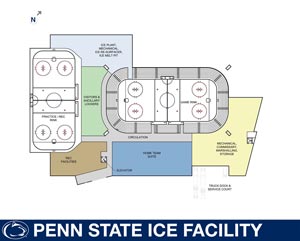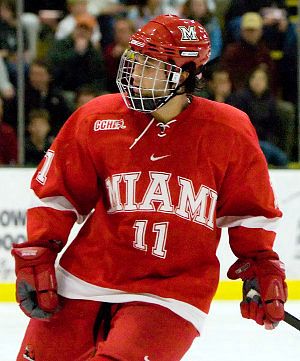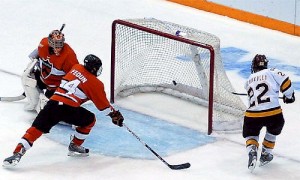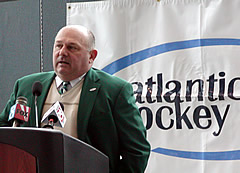The expected announcement of Penn State’s plans to add a varsity hockey program raises plenty of questions about how the move will change college hockey’s conference structure.
Members of the USCHO staff got together to discuss some of the issues.
Todd D. Milewski: So, USCHO roundtable, Penn State is on the verge of announcing a move to Division I varsity status. The Big Ten Conference is then in play. What’s the biggest change to the landscape going to be in the next five years?
Chris Lerch: I’m hoping this will lead to more, smaller conferences. With the current conferences maxed out, there’s no room for growth.
Jim Connelly: I think one of the biggest “issues” in the Big Ten existing as a six-team conference would be opening up the NCAA’s six-team requirement that could then split our current five-conference scenario, with a minimum of 10 teams in every conference, to a number of smaller, less “conference-like” conferences.
Paula C. Weston: I’m sighing heavily as I’m answering that question, Todd. What I want more than anything is for college hockey to grow and thrive without sacrificing what everyone genuinely loves about it: its sincerity, its relative lack of pretense, its coziness (for lack of a better word), its feeling of what college athletics should be about. What I fear, though, is that the sport will grow at the expense of all of that.
Jim Connelly: I don’t mind growth, Paula. I just want hockey to grow with the same objective of bringing a number of viable programs to the Division I level and placing them in conferences that are competitive.
Paula C. Weston: Chris, I’m hoping this will lead to realignment of conferences as well — we really do need to look at that issue.
Ed Trefzger: I agree that smaller conferences are inevitable. When four or more perennial NCAA playoff teams end up in the same conference, nabbing three or four bids among them, while perhaps the ECAC and Atlantic Hockey have three among 24 teams, the other conferences are going to do the math and look at realignment.
Jim Connelly: No doubt, Ed. I think that is one of the main issues. Little conferences want the same benefits of the major conferences. And I’m not sure if I feel that is right or wrong.
Todd D. Milewski: I think realignment at some level is inevitable. But should it be at the barrel of a gun? Because that’s what it seems like might be happening here.
Jim Connelly: I agree 100 percent, Todd.
Ed Trefzger: I don’t look at it as the barrel of a gun. Rather, it’s the event that may finally break the log jam that has existed for the past few years.
Paula C. Weston: Jim, let me clarify. I’m not against growth, not at all. I want to retain the feeling that college hockey has — and every current fan, coach, and media type knows what I mean by that. Just think back to the Frozen Four in Detroit (not to the games on the ice, but the atmosphere at the Renaissance Center). It’s unlike any other “big” collegiate sport.
Chris Lerch: I think on a macro level, the addition of Penn State and the inevitable Big Ten hockey conference will be a good thing. More visibility for the sport and I think more growth. I know the status quo is attractive for many schools, but I think the end result will be conferences based on geography and school size. I know it’s kind of cool for Lake Superior State to play Michigan and Merrimack to play Boston University, but in reality I think they belong in different conferences.
Jim Connelly: So Chris, do you think college hockey should adopt a more expansive “mid-major” conference presence? Teams with big budgets grouped together … and teams with small budgets grouped together?
Chris Lerch: Yes. I think it has to for the sport to grow.
Paula C. Weston: Again, I’m sighing heavily — and probably because the conference I’ve known and loved since 1996 is the one that stands to change the most. Having covered the CCHA since USCHO’s first year, I am saddened by what I see as a splitting of the conference. I agree, however, that a Big Ten conference would bring a lot of attention to college hockey.
Jim Connelly: A couple of days ago, Todd talked about how there have been only 17 NCAA champions all time in an excellent feature. I think if we align to a bunch of small conferences driven by program budgets we’ll never see another new national champ.
Paula C. Weston: Jim, that’s an excellent point.
Todd D. Milewski: I worry about what Jim mentions — that things seem to be trending toward a have and have-not division in college hockey, certainly more than there is now.
Jim Connelly: Chris mentions the sport having to grow… but how much growth does the sport need at this point?
Todd D. Milewski: My fear is for the smaller schools that have been catching up with some of the bigger schools over the last few years but may slip down the ladder after all this.
Chris Lerch: Jim, I would have to agree, although 17 out of 58 is a higher percentage than the other major NCAA sports. That is one thing that will be lost, probably — realistically in basketball there are hundreds of D-I programs with no hope of a national title.
Ed Trefzger: We’ve seen a growth in parity over the past few years. The schools with the blue chip players lose them to the NHL while smaller schools get to have their players mature. That’s made it possible for Atlantic Hockey to be competitive against the big boys. If money drives a Big Ten and a Hockey “Big” East, then that could widen again.
Jim Connelly: College hockey is already one of the most financially successful sports in the NCAA. Will growth help this? I’m not sure. I feel like there will be a dilution of talent that already is heading north of the border for major junior at an alarming rate. If you can’t get into one of the “have” programs, does major junior become the automatic option?
Paula C. Weston: Another thing I think about with the seeming inevitability of the Big Ten conference is how this may get the attention of big schools with football programs in other conferences. We all want the sport to grow. It’s difficult for a school without a money-making football program to add college hockey. There is a good number of big D-I southern schools with huge football programs and popular, competitive club teams. A Big Ten conference may get their attention, and I see that as a potential avenue for growth for the sport.
Todd D. Milewski: I think we have to note in this process that Penn State may be a unique situation. Not everyone has a very generous donor waiting to fund what is a very expensive program.
Jim Connelly: When does growth stop, though? I was highly involved when the MAAC (now Atlantic Hockey) and CHA began. At one point, there were more than 60 Division I programs. The truth was, though, that there wasn’t enough talent or money to keep all these programs. We’ve seen plenty of student-athletes lose the chance to play (Iona, Fairfield, Wayne State, etc.) and an entire conference was forced to contract.
Paula C. Weston: Jim, you raise another excellent point. Yes, I do think that growth is important for sustainability. I know out East that the economy is slightly better than it is here in the Midwest. As much as CCHA commissioner Tom Anastos denied that economics had a hand in denying Alabama-Huntsville admission to the CCHA last summer, I heard from sources off the record that it did — because schools in this region were fearful in these economic times. Growth from programs in bigger schools can definitely increase the revenue for the sport overall.
Chris Lerch: I think we’ll see more college hockey on TV — albeit the same six teams over and over.
Paula C. Weston: Yes, wouldn’t it be thrilling to see the same six teams on the BTN…over…and over…and over…
Jim Connelly: YAWN!
Chris Lerch: Kind of like the Red Sox and Yankees on ESPN.
Paula C. Weston: When were the Red Sox and Yankees on ESPN? I looked all summer … Like everyone else, I fear the haves/have-nots situation. Again, it’s something that’s discussed (behind closed doors) in the CCHA often enough.
Ed Trefzger: On the other hand, youth hockey continues to grow in the U.S. outside of its traditional areas in the Northeast and Midwest. And many players who could be role players on D-I teams do end up among the almost 80 D-III teams. So, while there may be a dilution to some extent, there are plenty of skilled players out there … especially if Paul Kelly and College Hockey Inc. can stem the tide of players going to major junior.
Jim Connelly: I feel that a haves/have-nots situation would lead to the smaller programs — namely the Division II and III schools playing up in hockey — to drop below the level of the competitive Division I schools.
Paula C. Weston: When we think of the immediate impact on the WCHA and CCHA — the two conferences with current Big Ten members — do we think that the WCHA has a better chance of remaining intact without Wisconsin and Minnesota than does the CCHA without Michigan, Michigan State, and Ohio State?
Jim Connelly: Personally, I do, Paula.
Todd D. Milewski: I think the WCHA sees itself as pretty strong even without Wisconsin and Minnesota. Not as strong as it is now, of course, but you still have major programs in North Dakota and Denver to be the anchors.
Paula C. Weston: That’s what I was thinking, Todd. Ed, there is good club and youth hockey all over the country. There’s more club hockey played than most people know.
Chris Lerch: Jim, but on a par with comparable schools. RIT, Clarkson and Rensselaer should be in the same league. Bowling Green and Robert Morris should be in the same league. The Ivies should go off on their own. Connecticut should be with Massachusetts and New Hampshire.
Ed Trefzger: I completely agree, Chris. That sort of realignment makes sense.
Jim Connelly: See, there is where I disagree, Chris. I know we’re talking specifics, but at UConn, hockey takes a major back seat to men’s and women’s basketball and now football. Hockey will never compete with other state schools in the region. They would get killed in a local state school conference.
Chris Lerch: Or maybe it forces UConn to step up or step out.
Jim Connelly: Step out, though, means shrinking the sport. Aren’t we trying to grow it?
Chris Lerch: Well, UConn just added scholarships last season, so hopefully it is beginning to step up. Its women’s program plays in Hockey East.
Paula C. Weston: And where does Notre Dame go, by the way?
Ed Trefzger: Notre Dame joins Syracuse and a team or two from the NYC area in Hockey Big East.
Jim Connelly: I just think that inadvertently, Chris brought up a good point. Hockey is attractive as a sport because there is opportunity for almost any program to be competitive. Heck, American International has given some good programs great games over time. But if you get into a haves vs. have-nots world, small programs may not be willing to commit to a lost cause.
Paula C. Weston: It’s not like some of the established conferences (in other sports) don’t have travel nightmares of their own, and I know that men’s ice hockey is trying to avoid some of the travel nightmares.
Todd D. Milewski: Here’s another point to discuss: The target season for a Big Ten start may be 2014-15. When do you think we start to see movement between conferences elsewhere? Does it happen before then to be ahead of the game?
Chris Lerch: Todd, only if there is some cooperation. Otherwise, it will be a reaction on the part of each conference.
Jim Connelly: And as we’ve learned over the past few summers, reaction is not the best way to handle things when it comes to conference alignment.
Ed Trefzger: I don’t think we’ve seen any signs of cooperation in the past few years, or college hockey wouldn’t be in the situation it is now, with no room for growth.
Paula C. Weston: Todd, I think it does. I think there’s a good chance that UAH comes into the CCHA in 2011-12, giving that program a couple of years to establish new consistent connections. I know for a fact that there is behind-closed-doors chatter about conference alignment, and that it’s pretty thick conversation in some places. I also know that Michigan and Michigan State do not want to break up the CCHA, so when that inevitability comes, they’ll be in on the discussions of realignment. Contrary to what a lot of people think, the big schools in the CCHA didn’t vote against UAH’s admission — and the big schools do care about the littler ones in the CCHA.
Ed Trefzger: There are some natural boundaries in two eastern leagues. The ECAC could split along the Ivies and non-Ivies, as was discussed. Atlantic Hockey has all but set up a split, scheduling an east and west division. Splits could happen, if teams and leagues are willing.
Chris Lerch: Is this good or bad for UAH? Even their fans are split on that.
Ed Trefzger: This could be good for UAH. Room in the CCHA could mean room in Atlantic Hockey, for example.
Chris Lerch: Yep. Does this just open six spots in the existing leagues that are backfilled in a domino fashion, or does it give the real chance for comprehensive change?
Paula C. Weston: Chris, I don’t think so. I think there’s some mixing.
Todd D. Milewski: I think right now UAH needs something to look forward to. Maybe there’s something in this, like Paula and Ed mentioned, to open some doors down the road and keep them in play until they can be accepted into a conference.
Paula C. Weston: UAH has many games scheduled against the CCHA this season, for what it’s worth.
Todd D. Milewski: A couple people I’ve talked to aren’t convinced that this leads to major change, even if it should. There are a lot of schools that have a lot invested in where they are now, and as we all know, things don’t change easily in college hockey.
Paula C. Weston: Another excellent point, Todd, and reminder that this is all speculation on our part. It may not lead to big changes. Maybe we’ll just see the five current Big Ten schools (and perhaps Notre Dame) absent themselves from their current leagues to form the BTC, leaving the other conferences to fill in gaps, where necessary. As I’ve said, I’m hoping it gives a few other club schools, like the universities of Kentucky and Georgia, some ideas.
Ed Trefzger: Or, Paula, some Pacific coast schools.
Paula C. Weston: Ed, my point is that UK and UGA have huge, huge club programs — but, yes, Pacific coast schools, too.
Jim Connelly: I personally think this is the long-awaited reason to form a bunch of small, six- or seven-team conferences … and I think that will happen. Teams would rather a 1-in-6 chance at the NCAA tournament than 1-in-14.
Ed Trefzger: I hope you are right, Jim. Here’s another question to ponder: Does having a Big Ten hockey conference finally give hockey a big voice at the NCAA table in the form of a multisport powerhouse representing its interests in Indianapolis?
Jim Connelly: Ed, you just made a point I’ve been meaning to make. Since the MAAC changed to Atlantic Hockey, hockey hasn’t had a seat at the NCAA table. That does make it difficult when it comes to legislative issues. Having a voice would be important.
Paula C. Weston: Ed, that’s a great question. The cynic in me says yes, given the amount of money potentially involved. Of course, having a voice would be great for college hockey.
Jim Connelly: Listen, Ed, everyone knows that Atlantic Hockey, even when it was the MAAC, knew that the league talked of splitting into two small conferences to get two autobids. The conference did what was right in other conferences eyes to make sure they didn’t stir the pot. But if the big schools begin splitting into small conferences, it’s carte blanche.
Todd D. Milewski: We’d have to trust that the voice that the Big Ten provides is the right one for college hockey. We’ll have to see on that one.
Paula C. Weston: Todd, I’m with you on that. Again, I’m a cynic.
Jim Connelly: Good point, Todd.
Paula C. Weston: Okay. Maybe not a cynic, but a skeptic.
Jim Connelly: Feels like the same thing, Paula.
Paula C. Weston: And, Todd, given the leagues you and I have covered, I think you know what I mean.
Paula C. Weston: Maybe it sounds that way, Jim, but I’m claiming skepticism rather than cynicism and I’m sticking to it. (Where is that smiley face emoticon?)
Todd D. Milewski: I think you have to be a little skeptical in all of this, especially about motives. Are Big Ten schools aligning to help make college hockey better, or make their six programs better in terms of college hockey? I hope it’s the former, but I worry it’s the latter.
Chris Lerch: Both, I hope.
Jim Connelly: I’ll leave you with one final thought: College hockey is STILL an old-boy network. The Big Ten is prime time. When the two clash, I’m not sure which survives. It will be, no doubt, a clash that has a strong potential to be very disruptive to the sport and possibly unseat some of the game’s legends who see this as their chance to “get out.” Something that is of great concern to me.
Paula C. Weston: Todd, I don’t think there’s any question that Big Ten schools would align for their own personal interest. Let me be clear here: I’m not talking about the coaches, and I’m not talking about every AD. In fact, we know that at least three current Big Ten schools wanted no part of a BTC last year, when the subject was brought up. But I think the universities themselves will be thinking only about the universities themselves. And yes, Jim, on that count I am a bona fide cynic.
Paula C. Weston: Jim, there will be collateral damage. Without question.
Ed Trefzger: These existing five are, after all, some of the most storied programs in college hockey, with a respect for the traditions of the sport. I don’t think the rest of the sport needs to suffer if they combine. And I don’t think it is in their interest for the rest of the sport to suffer.
Jim Connelly: Well said, Ed.
Paula C. Weston: Ed, the rest of the sport needn’t suffer, certainly. The coaches at these schools also do feel tremendous loyalty to college hockey, without question. That having been said, we are talking about the Big Ten — and not just hockey.






